King Solomon and the Queen of Sheba
David's role, and careful attention to all the details, plans and preparation for the temple are recorded for us in First Chronicles Chapter 22:
David commanded to gather together the aliens who were in the land of Israel, and he set stonecutters to prepare dressed stones for building the house of God. David also provided great stores of iron for nails for the doors of the gates and for clamps, as well as bronze in quantities beyond weighing, and cedar timbers without number - for the Sidonians and Tyrians brought great quantities of cedar to David. For David said, "Solomon my son is young and inexperienced, and the house that is to be built for the LORD must be exceedingly magnificent, of fame and glory throughout all lands; I will therefore make preparation for it." So David provided materials in great quantity before his death.
Then he called for Solomon his son, and charged him to build a house for the LORD, the God of Israel. David said to Solomon,
"My son, I had it in my heart to build a house to the name of the LORD my God. But the word of the LORD came to me, saying, You have shed much blood and have waged great wars; you shall not build a house to my name, because you have shed so much blood before me upon the earth. Behold, a son shall be born to you; he shall be a man of peace. I will give him peace from all his enemies round about; for his name shall be Solomon, and I will give peace and quiet to Israel in his days. He shall build a house for my name. He shall be my son, and I will be his father, and I will establish his royal throne in Israel for ever.' Now, my son, the LORD be with you, so that you may succeed in building the house of the LORD your God, as he has spoken concerning you. Only, may the LORD grant you discretion and understanding, that when he gives you charge over Israel you may keep the law of the LORD your God. Then you will prosper if you are careful to observe the statutes and the ordinances which the LORD commanded Moses for Israel. Be strong, and of good courage. Fear not; be not dismayed. With great pains I have provided for the house of the LORD a hundred thousand talents of gold, a million talents of silver, and bronze and iron beyond weighing, for there is so much of it; timber and stone too I have provided. To these you must add. You have an abundance of workmen: stonecutters, masons, carpenters, and all kinds of craftsmen without number, skilled in working gold, silver, bronze, and iron. Arise and be doing! The LORD be with you!" From Templemount
About the year 1000 B.C. there came to Egypt a character whose name is recorded as Saloman but who was identified in later years with Solomon.
The records show that he had come from the West, had traveled over many lands and across waters. He was of a nation which was large and important, situated in some very distant land. All this is indicated from the report he made to the representatives of the fraternity whom he interviewed at Thebes "whither he had gone immediately upon his arrival in Egypt accompanied by his slaves (!) and his najah (a word unknown to the translators)."
He desired instruction in the higher Egyptian sciences and philosophy, and was directed to El Amarna with a letter of introduction from the intendant at Thebes. He reached El Amarna on the 4th day of June, 999, under the name of Saloman, the youthful seeker.
Saloman did not complete his studies, for it is reported that he left El Amarna "before the fourth examination." He left with his Fratres and Sorores a definite feeling of love, wisdom, and virtue, and all were grieved at his sudden but announced departure.
The next word of him is as a resident at the royal home in Bubastis in the Delta where Shishak I (or Sheshonk) had established himself. This was in the year 952 B.C., and Saloman is referred to as an instructor to the Pharaoh's son. This is probably a mistake in translation, for in another place he is referred to as advisor in political matters, and this seems more probable in the light of future developments. Whether he had been at this residence all the intervening years from 999 to 952 B.C. is not definitely established, but there is a record of his presence.
At Thebes in the year 980 when he visited some games in company with the intendant of Thebes, and a group of scholars with whom he seemed on the most intimate terms.
Saloman seems to have been greatly influenced in Thebes and Bubastis by the religion of Ammon and conceived a form of philosophical religion which was a mixture of the Rosicrucian monotheism and the Egytian idolatry. To him the sun became more than the mere symbol of a God; it was the living vital spirit of God, and while not the God, it was God's ethereal body. This would indicate that Saloman conceived God as being (a) personal, rather than impersonal as the Rosicrucians taught, and (b) dual, body and spirit, Father and Holy Ghost.
When Shishak I secured Thebes he appointed his son priest in the religion of Ammon, and gave his daughter, Aye, to Saloman to wed. Then within a year or so Saloman departed for Palestine where he became a mighty power, and by a prearranged plan, permitted Shishak I to rule over his people. The history of Saloman or Solomon in Palestine is too well known to warrant any further comment except on one point.
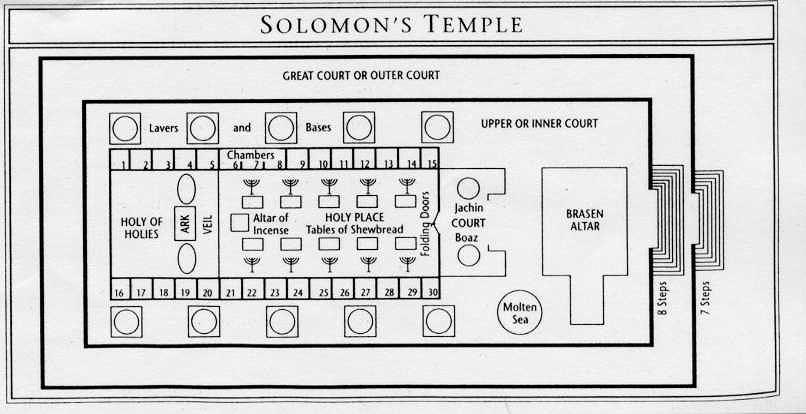 Five years after Saloman began his rule in Palestine he completed a Temple there in which to
house a "society" or brotherhood such as he had found at El Amarna. An examination of
the plans and cross-section views of the so-called Saloman's Temple shows it to be not only
typically Egyptian in architecture and decoration, but copied after the mystic Temple at El Amarna,
even to the location of the Altar, with the exception that the side structures which made the
original building a cross were eliminated in Saloman's plans.
Five years after Saloman began his rule in Palestine he completed a Temple there in which to
house a "society" or brotherhood such as he had found at El Amarna. An examination of
the plans and cross-section views of the so-called Saloman's Temple shows it to be not only
typically Egyptian in architecture and decoration, but copied after the mystic Temple at El Amarna,
even to the location of the Altar, with the exception that the side structures which made the
original building a cross were eliminated in Saloman's plans.
Saloman had the assistance of two who had traveled in Egypt as architects and artists - Hu-ramabi of Tyre and one Hiram Abif.
The Saloman brotherhood was closely watched by the fraternity in Egypt, which had removed its headquarters to Thebes again because of political changes and the warring invasions in the territory of El Amarna, which eventually reduced the entire community to ruins.
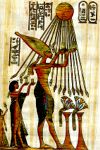 It was found that Saloman restricted his order to males and adapted a great many of the
details of the Rosicrucian initiations and services. At first it was believed that he would apply
to the Grand Lodge in Thebes for a charter and make his work a branch of the R. C., but it
became apparent before the first assembly was held that he was not adhering to the
{p. 71} Rosicrucian philosophy, for he used the sun as the exclusive symbol of his order.
It was found that Saloman restricted his order to males and adapted a great many of the
details of the Rosicrucian initiations and services. At first it was believed that he would apply
to the Grand Lodge in Thebes for a charter and make his work a branch of the R. C., but it
became apparent before the first assembly was held that he was not adhering to the
{p. 71} Rosicrucian philosophy, for he used the sun as the exclusive symbol of his order.
Of the growth of the Saloman brotherhood, as it was socially called in all ancient documents, one may read in all literature bearing upon Freemasonry. It has evolved into a semi-mystical, speculative, secret, fraternal order of power and great honor, gradually altering the principles laid down by Saloman, it is true, but doing so for the greater benefit of man. from Akhenaten
The first evidence of this is in the subsequent relocation of the Solomonic period to the Late Bronze Age. This was an age of wealth and prosperity in the Levant, reflecting the biblical narrative of the wealth of Solomon's reign. Previously, Solomon was placed in a period of general impoverishment - the Early Iron Age. The contemporaries of Solomon in Egypt are now shown to have been Haremheb and Seti I.
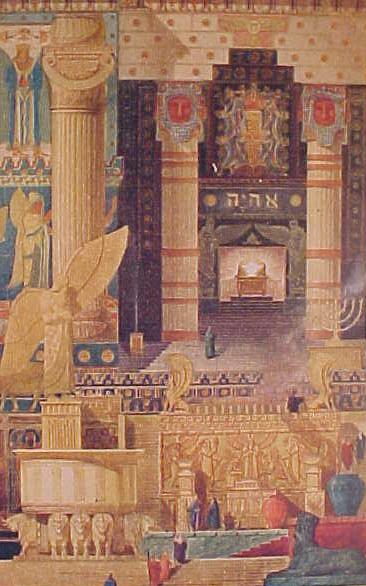 Excavations at Megiddo for
this period, which I Kings 9:15 records as being built up by Solomon,
revealed a Late Bronze Age palace 50 metres long with two-metre thick walls, a royal
treasure-room with a magnificent hoard of treasures and the richest collection of Canaanite
carved ivory yet discovered' in Palestine (Yigael Yadin of the University of Jerusalem). One
of these ivory pieces depicts a king on his throne flanked by two sphinxes with his queen
before him. The queen is presenting the king with lotus flowers, a typical Egyptian scene.
In I Kings 10:18-20, Solomon is said to have had a throne flanked with lions'. We also know
that he married an Egyptian princess (I Kings 3:1). Could this piece, now in the Rockefeller
Museum in Jerusalem, represent Solomon and his Egyptian queen at the height of their
power? The architecture of Late Bronze Age Megiddo is identical to that described in the
Bible as being performed by Phoenician craftsmen (I Kings 6:36).
Excavations at Megiddo for
this period, which I Kings 9:15 records as being built up by Solomon,
revealed a Late Bronze Age palace 50 metres long with two-metre thick walls, a royal
treasure-room with a magnificent hoard of treasures and the richest collection of Canaanite
carved ivory yet discovered' in Palestine (Yigael Yadin of the University of Jerusalem). One
of these ivory pieces depicts a king on his throne flanked by two sphinxes with his queen
before him. The queen is presenting the king with lotus flowers, a typical Egyptian scene.
In I Kings 10:18-20, Solomon is said to have had a throne flanked with lions'. We also know
that he married an Egyptian princess (I Kings 3:1). Could this piece, now in the Rockefeller
Museum in Jerusalem, represent Solomon and his Egyptian queen at the height of their
power? The architecture of Late Bronze Age Megiddo is identical to that described in the
Bible as being performed by Phoenician craftsmen (I Kings 6:36).
Read I Kings 2:13-11:43
UNDER Solomon, national and religious self-consciousness, encouraged by the king and the temple priesthood, resulted in the production of a great body of literature, of which the Davidic record was but a part. Unfortunately, no biographical data like that pertaining to David have come to us from the reign of Solomon, nor from those rulers that succeeded him. Instead, a history developed by the Deuteronomists is all that remains. The compilers acknowledge some of their sources, including "The Book of the Acts of Solomon" (I Kings 11:41), "The Book of the Chronicles of the Kings of Israel" (I Kings 14:19), and "The Book of the Chronicles of the Kings of Judah" (I Kings 14:29), but it is difficult to determine what material may have come from these sources, and it is impossible to know what principles guided the Deuteronomists in their selection of data. Within the stories pertaining to Solomon's reign numerous Deuteronomic additions can be recognized and, when these are removed, a sketchy literary picture of the monarch's career remains, an account which appears to be relatively correct. Archaeological evidence has helped to fill in other details.
Following David's death Solomon acted quickly to strengthen his position. Those who might have presented a challenge to his rule (I Kings 2:13-46) were eliminated. Adonijah requested Abishag, the young woman who had been David's last concubine, as a wife. It has been noted previously that such a request was tantamount to seeking to take the place of the dead monarch, as Solomon's response clearly indicates:
"Ask for him the kingdom also; for he is my elder brother and on his side are Abiathar the priest and Joab the son of Zeruiah."
- I Kings 2:22
This request brought about Adonijah's murder. Abiathar was spared and sent to Anathoth, perhaps because he was a priest. When Joab learned of Solomon's program he fled to a shrine, but even as he clung to the horns of the altar, Solomon's executioner, Benaiah, murdered him. Shimei, whose loyalty to the family of Saul had never wavered, was finally killed when he violated parole. For his services Benaiah was made commander-in-chief of the army. The editors summarize the discussion of the strategic murders with the statement "So the kingdom was established in the hand of Solomon."
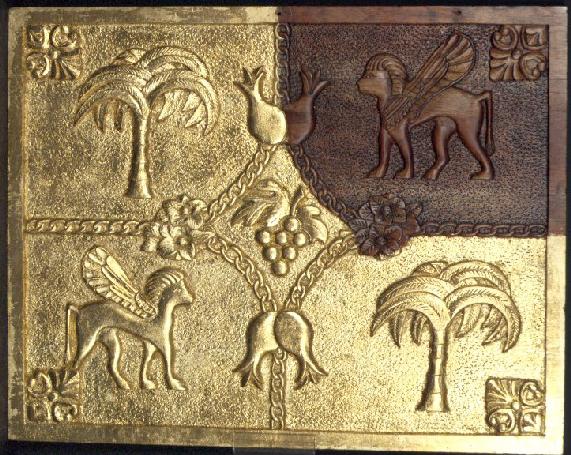 Solomon's biographer appears to have been impressed with certain facets of Solomon's career
— his marriages, his wisdom, his wealth, his buildings, and his international business dealings.
Of Solomon's 700 wives and 300 concubines (I Kings 11:3a), only Pharaoh's daughter is singled
out for specific mention. This marriage demonstrates the wealth and power of the Hebrew
monarchy, for Pharaoh's daughters did not ordinarily marry outside of their own family, and
perhaps indicates the weakness of the Egyptian kingdom at this time. This strategic marriage
provided a basis for trade relationships (10:29) and gained for Solomon's empire the city of
Gezer as a wedding payment (9:16). How important the marriage was in Solomon's eyes is
perhaps demonstrated by the fact that of all his wives only Pharaoh's daughter appears to
have had a special apartment built for her within the royal palace (7:8; 9:24).
Solomon's biographer appears to have been impressed with certain facets of Solomon's career
— his marriages, his wisdom, his wealth, his buildings, and his international business dealings.
Of Solomon's 700 wives and 300 concubines (I Kings 11:3a), only Pharaoh's daughter is singled
out for specific mention. This marriage demonstrates the wealth and power of the Hebrew
monarchy, for Pharaoh's daughters did not ordinarily marry outside of their own family, and
perhaps indicates the weakness of the Egyptian kingdom at this time. This strategic marriage
provided a basis for trade relationships (10:29) and gained for Solomon's empire the city of
Gezer as a wedding payment (9:16). How important the marriage was in Solomon's eyes is
perhaps demonstrated by the fact that of all his wives only Pharaoh's daughter appears to
have had a special apartment built for her within the royal palace (7:8; 9:24).
Solomon's wisdom, extolled by the editor of Kings, became the symbol of all wisdom for later Hebrew history. Not only were portions of the book of Proverbs ascribed to him, but Ecclesiastes, the Song of Songs and the Wisdom of Solomon were composed in his name. None of these writings are believed to be the work of the Hebrew monarch. According to I Kings 4:29-34 Solomon is supposed to have composed proverbs and songs, but the specific themes which are said to be the subject of these compositions are scarcely mentioned in the writings bearing Solomon's name.
Solomon may have composed wise sayings, but it is more likely that his reputation for wisdom rests upon a different and somewhat more significant base. Within the courts of the ancient Near East, the wise man held an office of special honor. Jeremiah put wise men of Babylon in the same category as princes (Jer. 50:35). The high standing of the wise man is reflected in Egyptian literature, for Amen-em-opet was controller of the land, and the "councils of Duauf," which probably come from the fourteenth century, link wisdom with the scribe along with the comment that every court office lay open to such a person. It is possible that Solomon's reputation for wisdom stems from the establishment of a wisdom school par excellence within the royal court, rather than from his own personal contribution to wisdom literature. In a kingdom so young and in a court so recently organized, the establishment of such a school with an international reputation was worthy of record. How much support subsequent monarchs gave to the wisdom school cannot be ascertained, but the caption above Chapter 25 of Proverbs indicating that the material was copied by "Hezekiah's men" may have reference to royal patronage. If this interpretation of the scanty references is correct, Solomon's fame as a wise man is, perhaps, justified.
Perhaps the king's most important role for his biographers was as the builder of the temple of Yahweh. Construction details are set forth in I Kings 6, and the manufacture of the accoutrements is recorded in I Kings 7:9-50. From his sources the editor drew information concerning the trade agreements between Solomon and Hiram, King of Tyre. Twenty Galilean cities, plus Hebrew grain and oil, were exchanged for timber and gold (5:1, 6-12; 9:10-14). Labor was recruited through the corvée or forced labor policy.
A figure as colorful as Solomon would naturally attract legends. Folktales developed about his wealth (10:14-25), trade (10:11-12), and international reputation for wisdom (3:16-28; 10:1-10). The final touch was added by Deuteronomists who are responsible for the account as we have it. Stern judgment was passed upon Solomon for his numerous wives who led him to worship other deities beside Yahweh. At the same time, the speeches placed in Solomon's mouth reflect Deuteronomic convictions about the significance of the Hebrew religion and contain interpretations of history that follow the Deuteronomic point of view.
In I Kings 9:15, Solomon is recorded as having built the Millo' around Jerusalem. This was a massive stone terrace, erected to increase the building area on top of the City of David. This amazing construction was extensively excavated by Dame Kathleen Kenyon; however, due to the chronological problems already discussed, it was wrongly dated to a couple of centuries before Solomon. This has now been revised under the new chronology and given a date in the Late Bronze Age, contemporary with Solomon, the biblical builder.
Furthermore, it is stated in I Kings 7:8 and II Chronicles 8:11 that Solomon built a palace for his Egyptian wife in Jerusalem. The only Egyptian architectural remains ever to be found in Jerusalem now date in the new chronology to the Late Bronze Age II A/B. Previously, it was considered a mystery as to where they had come from and who had been responsible for them.
There is perhaps no building of the ancient world which has excited so much attention since the time of its destruction as the Temple which Solomon [Shlomo -- from Shalom] built at Jerusalem, and its successor temple as rebuilt by Herod. Its spoils were considered worthy of forming the principal illustration of one of the most beautiful of Roman triumphal arches, and Justinian's highest architectural ambition was that he might surpass it. Throughout the Middle Ages it influenced to a considerable degree the forms of Christian churches, and its peculiarities were the watchwords and rallying-points of all associations of builders. Since the revival of learning in the 16th century its arrangements have employed the pens of numberless learned antiquarians, and architects of every country have wasted their science in trying to reproduce its forms.
Solomon's Temple was set upon the "rock" of Mount Moriah, looking east over the Valley of Kidron. It took seven years to build, was built with huge gangs of forced labor, and was constructed without the sound of a hammer or axe or any tool of iron. Though relatively small in size, there was a manifest magnificence to it. Its three parts were the porch or hall [elam], the holy place or shrine [hekal], and the holy of holies -- the inner sanctum [devir]. Its notable twin pillars are something of a mystery. Free-standing, covered with brass, the pillars had names Jachin and Boaz.
It was within the holy of holies that the Ark of the Covenant was preserved, and the Mercy Seat. The holy of holies was a perfect cube, twenty cubits by twenty cubits by twenty cubits. Between this innermost sanctum and the holy place was a double veil of finest material, elaborately embroidered. The outer of the veils was open at the north, the inner at the south. The high priest entered at the appointed time, once a year, on the day of atonement. Within the Ark was contained the record or testament of the Lord.
After the Babylonian captivity and the rebuilding of the temple [587 BC] the holy of holies was empty except for the large stone on which the high priest sprinkled the sacrificial blood once a year, on the day of atonement.
The Temple's chief craftsman and designer-architect was a mixed blood Israelite named Hiram Abiff, truly a man of mystery, gifted with occult skills and esoteric knowledge. He it was who cast the bronze furnishings and ornate decorations for the new temple of Solomon. Biblically, the little we know or the rest we can infer, Hiram's mother was Israelite (of Naphtali), his father a man of Tyre. History knows him as the widow's son, an artificer in brass and copper. Hiram lived or at least temporarily worked in clay banks in the plain of the Jordan between Succoth and Zarthan.
The builders made lavish use of the gold of Ophir and Parvaim. From the east it glittered in the morning sun like the sanctuary of an El Dorado. The accumulated gold and silver available to Solomon from his inheritance from David must have been (in present value) in the billions of dollars. Along with the Temple -- with its crenellated battlements -- as well as government buildings -- his palace and court and harem, Solomon was turning Jerusalem into a veritable show-case throughout the ancient world, much of its style along Punic-Phœnician lines.
Solomon embarked on vast commercial enterprises, created a merchant navy which plied the Red Sea and the Indian Ocean -- including, we are told, India herself. His port was Elath, by Ezion-Geber, with its rich copper deposits nearby, which he exploited on a large scale. On land his merchants monopolized the caravan trade in horses between Syria (Aram) and Egypt and the kingdoms of the Nile.
The sea trade with India is a tantalizing mystery. Even 1000 years BC, India was the wealthiest nation on earth. Fabulous jewels were stowed there; there were caves full of them, gold and treasures horded in cold, underground vaults (reputedly guarded by dragons and other real or mythical creatures); there were jewels glittering in temples and on every image. Jewels, spices, silks -- even in the days of Marco Polo, even in the times of Vasco da Gama and Cristopher Colombus, the vast wealth of the East inspired the imagination of seekers whose quests would turn the world upside down.
The Biblical Hebrew account of Solomon [Shlomo -- from Shalom] gives us the following glimpse.
- And God gave Solomon wisdom and understanding exceeding much, and largeness of heart, even
as the sand that is on the sea shore.
- And Solomon's wisdom excelled the wisdom of all the children of the east country, and all the wisdom of Egypt.
- For he was wiser than all men; than Ethan the Ezrahite, and Heman, and Chalcol, and Darda, the sons of Mahol: and his fame was in all nations round about.
- And he spake three thousand proverbs: and his songs were a thousand and five.
- And he spake of trees, from the cedar tree that is in Lebanon even unto the hyssop that springeth out of the wall: he spake also of beasts, and of fowl, and of creeping things, and of fishes.
- And there came of all people to hear the wisdom of Solomon, from all kings of the earth, which had heard of his wisdom.
- And Hiram king of Tyre sent his servants unto Solomon; for he had heard that they had anointed him king in the room of his father: for Hiram was ever a lover of David.
- And Solomon sent to Hiram, saying,
- Thou knowest how that David my father could not build an house unto the name of the LORD his God for the wars which were about him on every side, until the LORD put them under the soles of his feet.
- But now the LORD my God hath given me rest on every side, so that there is neither adversary nor evil occurrent.
- And, behold, I purpose to build an house unto the name of the LORD my God, as the LORD spake unto David my father, saying, Thy son, whom I will set upon thy throne in thy room, he shall build an house unto my name.
- Now therefore command thou that they hew me cedar trees out of Lebanon; and my servants shall be with thy servants: and unto thee will I give hire for thy servants according to all that thou shalt appoint: for thou knowest that there is not among us any that can skill to hew timber like unto the Sidonians.
- And it came to pass, when Hiram heard the words of Solomon, that he rejoiced greatly, and said,
- Blessed be the LORD this day, which hath given unto David a wise son over this great people.
Phœnicia Nourished by trade and skillfully governed by a mercantile aristocracy too clever in diplomacy and finance to waste their fortune in war, the cities of Phœnicia rose to a place among the richest and most powerful in the world. Byblos thought itself the oldest of all cities; the god El had founded it at the beginning of time. Because Papyrus was one of the principal articles of its trade, the Greeks took the name of the city as their word for book - biblos - and from their word for books named our Bible - ta biblia.
Greatest of the Phœnician cities was Tyre -- i.e, the rock -- built upon an island several miles off the coast. It, like Sidon, began as a fortress, but its splendid harbor and its security from attack soon made it the metropolis of Phœnicia, a cosmoplitan bedlam of merchants and slaves from the whole Mediterranean world.
Saul and The Amarna Tablets
In 1887, 380 clay tablets were discovered in Egypt at a place called Tell el-Amarna and have come to be known as the Amarna tablets. These tablets were letters from foreign rulers, mainly of city-states but also of the more powerful northern kingdoms of present-day Syria, Turkey and Cyprus, as well as what was once Babylonia and Assyria. They were written to the Egyptian pharaoh of the day; this was Amenhotep IV who soon changed his name to the famous Akhenaten.
Under the old chronology these tablets contained little to interest Bible scholars; however, under the new chronology they are dated to the late 10th century of Saul and David, providing an amazing confirmation and even expansion of the biblical narrative. The tablets were carried to Egypt, transcribed onto papyrus from the original Akkadian/Cuneiform script into heiroglyphs for the pharaoh to read and then the original tablets stored at Amarna to be discovered some 3000 years later.
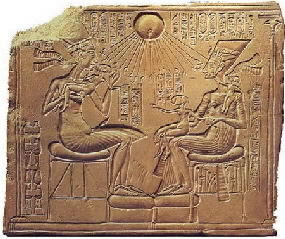 Akhenaten was the 18th Dynasty ruler who sought to change the entire religion and
culture of Egypt to the worship of one deity, the sun-god Re, in the form of the Aten sun disc.
Under his rule, however, Egypt became militarily weak and was brought to the brink of revolution.
The superpower of the day was crippled, allowing a new power base to emerge in the Levant under
the rule of firstly Saul, then David. This culminated in the reign of Solomon, with enough
consolidated power to force a marriage alliance between himself and a later pharaoh's daughter.
Akhenaten was the 18th Dynasty ruler who sought to change the entire religion and
culture of Egypt to the worship of one deity, the sun-god Re, in the form of the Aten sun disc.
Under his rule, however, Egypt became militarily weak and was brought to the brink of revolution.
The superpower of the day was crippled, allowing a new power base to emerge in the Levant under
the rule of firstly Saul, then David. This culminated in the reign of Solomon, with enough
consolidated power to force a marriage alliance between himself and a later pharaoh's daughter.
The Amarna tablets paint a picture of a tribal Palestine ruled by various city-state rulers of Canaanite, Philistine and Israelite/Hebrew origin as well as the larger state of Amurru/Aram to the north, very much corroborating the biblical picture of Samuel. They tell us that the coastal plains were in the hands of Philistines of Indo-European origin, dominated by city-state rulers with Indo-European names who communicate with Pharaoh Akhenaten in the Amarna letters. The Bible tells of the coastal plains being out of the control of Saul and under Philistine rule (p.207, fig. 244). The city of Gezer in the Amarna letters is under Canaanite rulers; Gezer in the Bible is under Canaanite rule until given to Solomon as a dowry by Pharaoh in I Kings 9:16.
Mentioned several times in the tablets are the Habiru' people, who are stateless wanderers outside the rule of the city-states of Palestine and Syria, often employed as mercenaries by these rulers to protect their interests. Their lifestyle closely resembles that of the biblical Hebrews and yet posed problems for scholars under the old dating system as to why groups of Hebrews should be wandering in Palestine 100 years before the Exodus! Now, however, these are the Hebrews of David who finally enter the service of Achish, king of Gath, who quarters them in Gath. David and his Hebrews, portrayed as soldiers of fortune as in I Samuel 27:1-6!
In the Amarna letters, Jerusalem is ruled by Jebusites, a Hurrian elite race. In II Samuel 5:6,7, this is also the case until the city is conquered by David. The name of the ruler of Jerusalem is given in the Amarna letters as Abdiheba, a mixed Semitic/Hurrian name. The Amarna tablets tell of the whole region of Syria dominated by kings of Amorite stock including a king Aziru. The Bible in II Samuel speaks of this kingdom being Aram and the king being Hadadezer, one of David's enemies. Aziru is considered to be the accepted shortening or hypocoristicon of a longer, more formal name. Given that Hadad was a prominent god of the Arameans and that -Aziru (or -ezer) means helper of', it can be seen that the Amarna letters use the shortened name of the Aramean king Helper of Hadad' or Hadadezer, a startling biblical confirmation.
The hill country to the north of Jerusalem is dominated in the Amarna letters by a king who shows scant respect for the Egyptian pharaoh. His hypocoristic or shortened name is Labayu, translated as Great Lion of (N)' where N is a god's name. The career of the Labayu in the Amarna letters is strikingly similar to that of Saul and this is an alternative name for the biblical Saul, 'the great lion' of Yahweh.
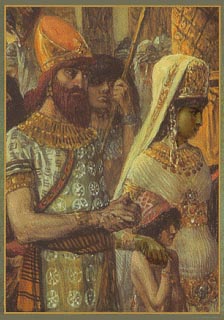
QUEEN OF SHEBA (So. Arabia Sabaran - 950 BC)
Return to Sheba
The legend of Solomon and Sheba is one of great mythopoeic power that has infiltrated numerous cultures outside Ethiopia. The earliest known version is preserved in two books of the Old Testament. Here we are told that the Queen of Sheba, lured by Solomon's fame, journeyed to Jerusalem with a great caravan of costly presents and there "communed with him of all that was in her heart". King Solomon, for his part, "gave to the Queen of Sheba all her desire . . . So she turned and went to her own land, she and her servants." The Talmud also contains oblique references to the story, as does the New Testament (where Sheba is referred to as "the Queen of the South").
There is, in addition, a fairly detailed account in the Koran, echoed in several Arabic and Persian folk tales of later date (in which she is known as Bilqis). Further afield, in southern Africa, the enigmatic stone ruins of Great Zimbabwe are said by the local Mashona people to have been the palace of the Queen of Sheba, and tribal elders still repeat their own fully evolved version of the legend. Of all these different narratives, however, it is the Ethiopian variant (where Sheba's name becomes Makeda) that is the richest and the most convincing - despite the fact that it does not seem to have been set down in writing until medieval times when it appeared in the Kebra Nagast (Glory of Kings), the Ethiopian national saga.
One thing is certain: the veneration of the Queen of Sheba - and her appropriation as the spiritual ancestress of the Ethiopian people - began much earlier than the fourteenth century (when the Kebra Nagast was written); indeed, the cult of Makeda probably substantially predates the Christian era. As a historical figure she is thought to have lived in the period between 1000 and 950 BC and, despite a rival claim from South Arabia, the evidence is extremely strong that her capital was indeed in Abyssinia - although not necessarily in the city of Axum.
It is in Axum, however, that the Ethiopians locate her. From here, according to the Kebra Nagast, she was persuaded to travel to the court of Solomon by the head of her caravans - a man much impressed by the King's wisdom and might. In Jerusalem a banquet of specially seasoned meat was given in her honour and, at the end of the evening, Solomon invited her to spend the night in his chambers. Makeda agreed, but first extracted a commitment from the King that he would not take her by force. To this he assented, on the single condition that the Queen make a promise not to take anything in his house. Solomon then mounted his bed on one side of the chamber and had the Queen's bed prepared at the other side, placing near it a bowl of water. Made thirsty by the seasoned food, Makeda soon awoke, arose, and drank the water. At this Point Solomon seized her hand and accused her of having broken her oath; he then "worked his will with her".
That night the King dreamt that a brilliant light, the divine presence, had left Israel. Shortly afterwards the Queen departed and returned to her country and there, nine months and five days later, she gave birth to a son - Menelik, the founder of Ethiopia's Solomonic dynasty.
In due course, when the boy had grown, he went to visit his father who received him with great honour and splendour. After spending a year at court in Jerusalem, however, the prince determined to return once more to Ethiopia. When he was informed of this, Solomon assembled the elders of Israel and commanded them to send their first born sons with Menelik. Before the young men departed, however, they stole the Ark of the Covenant and took it with them to Ethiopia - which then, according to the Kebra Nagast, became "the second Zion".
The notion that the Ark of the Covenant was removed from Jerusalem to Axum is central to the reverence accorded to the tabots, the Tablets of the Law, in Abyssinian Christian practices. The belief system of which the tabots are a part is, however, an unusual one. No other Christian Church gives such importance to what is, by definition, a pre-Christian - indeed a Judaic - tradition. Furthermore, the Christian faith did not itself reach Ethiopia until the fourth century AD - some one thousand three hundred years after Solomon's rule in Israel. The only satisfactory explanation for the unique position given to the Ark and to the tabots, therefore, is this: in Old Testament times, there must have been a period when there were very close cultural and religious links between Abyssinia and the Holy Land. Could it not be that the Queen of Sheba "legend" and the story of Menelik bear witness to this deeper truth?
Axum's greatest significance, however, is not as an archaeological site but rather as the supposed capital of the Queen of Sheba - the capital from whence she set out on her legendary visit to the court of Solomon in Jerusalem. Upon this story, with some unusual embellishments, rests the notion of the sacral kingship of the Semitic peoples of Ethiopia - a notion that links the recent past to ancient times in a most unambiguous fashion. Emperor Haile Selassie was, after all, the 225th monarch of a dynasty that traced its descent back to the union of Solomon and Sheba. The revolution of 1974, and the Emperor's death in obscure circumstances a year later, thus marked the end of an immense era - and the beginning of the end for an entire way of life and an entire system of values associated with it.
Before the approaching desert storm, the Queen of Sheba stands thoughtfully, reflecting on her visit with King Solomon. she must realize that, indeed, the end of the era for reigning matriarchy, in the Middle East, certainly her own queendom is in its last dim shadow of the sands and the gifts of Solomon are but hollow coins.
Although received royally as an equal and with respect by King Solomon, it is stated that when she viewed the splendor of Solomon's court and acknowledged his wisdom, the spirit left her.
Little is known of the Queen of Sheba, not even her name, other than she traveled a vast distance form her country, generally believed to have been Saba located in South West Arabia; however, the vast mines of the area were located far to the north.
Are Sheba and Hatshepsut, one and the same?
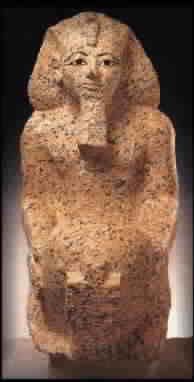
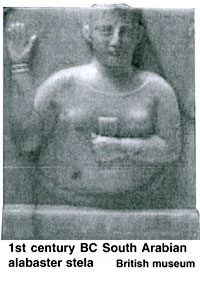 Hatshepsut, the Queen of Sheba, and Immanuel Velikovsky;
On page 105, Velikovsky writes, “If Solomon was really a renowned
king, as the Hebrew sources describe him, then the absence of
any contact between this queen and this king is difficult to
explain. It would, indeed, be very singular, for these two rulers
were no ordinary occupants of throne halls, but very excellent
suzerains. Nor would it fit our notion of the adventure-loving
character of Queen Hatshepsut, or the words of praise: ‘Thy
name reaches as far as the circuit of heaven, the fame of Makare
(Hatshepsut) encircles the sea,’ and ‘her fame has encompassed
the Great Circle’ (ocean). Neither would it accord with our idea
of King Solomon, whose capital was visited by ambassadors from
many countries and who had personal contact with many sovereigns:
“And all the kings of the earth sought the presence of Solomon’
(II Chronicles 9:23), and ‘all the earth sought to Solomon. . .
.’ (I Kings 10:24). Was the queen of Egypt excluded from ‘all
the kings’?”
Hatshepsut, the Queen of Sheba, and Immanuel Velikovsky;
On page 105, Velikovsky writes, “If Solomon was really a renowned
king, as the Hebrew sources describe him, then the absence of
any contact between this queen and this king is difficult to
explain. It would, indeed, be very singular, for these two rulers
were no ordinary occupants of throne halls, but very excellent
suzerains. Nor would it fit our notion of the adventure-loving
character of Queen Hatshepsut, or the words of praise: ‘Thy
name reaches as far as the circuit of heaven, the fame of Makare
(Hatshepsut) encircles the sea,’ and ‘her fame has encompassed
the Great Circle’ (ocean). Neither would it accord with our idea
of King Solomon, whose capital was visited by ambassadors from
many countries and who had personal contact with many sovereigns:
“And all the kings of the earth sought the presence of Solomon’
(II Chronicles 9:23), and ‘all the earth sought to Solomon. . .
.’ (I Kings 10:24). Was the queen of Egypt excluded from ‘all
the kings’?”
Her route to Jerusalem is not known. Possibly she traveled by land up the eastern coast of the Red Sea, or crossed the sea and traveled through Ethiopia and Egypt (some legends associate her with these two countries), or perhaps she sailed the greater distance on the Red Sea. However she traveled, it was with an enormous caravan for she brought a fortune in gifts for Solomon -- 120 talents of gold ($4,000,000.00), precious gems and many exotic and rare spices.
On page 106, Velikovsky quotes the motive for the queen of Sheba’s journey: “‘And when the queen of Sheba heard of the fame of Solomon, she came to prove Solomon with hard questions at Jerusalem. . . .’” The motive for Hatshepsut’s expedition, as preserved in the Egyptian records, is presented as a command of the god Amon: “Sailing . . . to the land of Punt . . . according to the command of the Lord of Gods, Amon, lord of Thebes, presider over Karnak, in order to bring for him the marvels of every country, for he so much loves the King of Upper and Lower Egypt . . .
The administration and taxation system of Amenhotep with its 12 districts is identical to that of Solomon as described in the Bible (1 Kings 4:2-7,27; 5:13; 9:23). Amenhotep also dedicated himself to rediscovering the wisdom, mysteries and traditions of earlier Egyptian Dynasties. A strong relationship has been established between the "Proverbs of Solomon" in the Bible and the "Maxims of Amenhotep III" found in Egypt.
In addition to the projects already mentioned, Amenhotep also built a completely new palace
complex in Thebes. The new royal residence included all of the elements contained in the
palace complex of Solomon which are described in the Bible (1 Kings 7:2-12), namely:
a house made almost entirely out of cedars of Lebanon (built for Amenhotep's Jubilee festival);
a colonnade (hall of columns) fronted by a portico (porch) and surrounded by a column-lined courtyard;
a throne room built with many wooden columns and whose floor was a painted lake scene (identical
to the one crossed in wonder by the Queen of Sheba when she approached the throne of Solomon,
as described in the Koran);
a separate palace built for Sitamun, "the daughter of Pharaoh;"
a royal palace (consisting of his own residence, the residence of his Great Wife, Tiye,
and a residence for the royal harem).
Is Solomon actually Amenhotep III? see this site for the details.. "It was customary and obligatory for Amenhotep III to marry "the daughter of Pharaoh" in order to secure the throne. This is precisely what was done when he was married to Sitamun, the daughter of his father, Pharaoh Thutmose IV."
The "inescapable conclusion" is that the story of Solomon was patterned specifically after the life of Amenhotep III. The name Solomon itself, which literally means "peace" or "safety" points to Amenhotep III whose long and pervasive reign in the 14th Century B.C. did not include any major military campaigns, but was characterized by unprecedented stability throughout the Near East. After the Egyptian 18th Dynasty, the region between the two great rivers was not controlled by a single power again until the Assyrian empire of Ashurbanipal (the grandson of Sennacherib) who invaded Egypt and pillaged Thebes in the 7th Century B.C., and the 6th Century B.C. empire of Cyrus, who also conquered Egypt and made it a Persian province. There is no evidence of any empire at any time controlling this region whose capital was Jerusalem. see Amenhotep III
Sheba: One must ask ones self why she was determined to take this pilgrimage. The magnificence of Solomon's wealth, wisdom and power was well established. It seems reasonable that the Queen, allowing for her curiosity in Solomon himself, felt it expeditious to form a bond of friendship between the two kingdoms in order to protect her country from invasion.
...a command was heard from the great throne, an oracle of the god himself, that the ways to Punt should be searched out, that the highways to the Myrrh-terraces should be penetrated: ‘I will lead the army on water and on land, to bring marvels from God’s-Land for this god, for the fashioner of her beauty’” “[a decree of] my majesty commanding to send to the Myrrh-terraces, to explore his ways [for him,] to learn his circuit, to open his highways, according to the command of my father, Amon”; and “I have hearkened to my father . . . commanding me to establish for him a Punt in his house, to plant the trees of God’s-Land beside his temple, in his garden, according as he commanded...
After such a long journey, the Queen must have spent enough time querying Solomon of the riddles so prevalent of the period, analyzing his wisdom and surveying the opulence of his court that she soon gained an insight to her own vulnerability. Perhaps with this intuition the spirit left her.
On page 107, Velikovsky cites Josephus’ account of the
queen of Sheba’s journey, which begins, “Now the woman who at
that time ruled as queen of Egypt and Ethiopia. . . .” On page
127, he quotes Josephus again: “And the queen of Egypt and
Ethiopia . . . returned to her own country.”
more..
Queen of Sheba, Articles
Upon her departure, as was the custom, Solomon gave her of his royal bounty. What held the greatest worth, her insight or Solomon's hollow gifts?
The Temple Solomon built for his Queen
The first battle of Megiddo has been placed at 1478 BC. This date would place the tribe of Manasseh in the city, of Megiddo where the Canaanites lived. The tribe did not succeed in driving the Canaanites out..Judges 2: 27 - 29. Numbers 33: 50 - 56. God had instructed Joshua and the tribes of Isreal to destroy this temple and the people. The date of this order follows closely with the time line. [placing the final date of the arrival in Israel around 1456BC.]
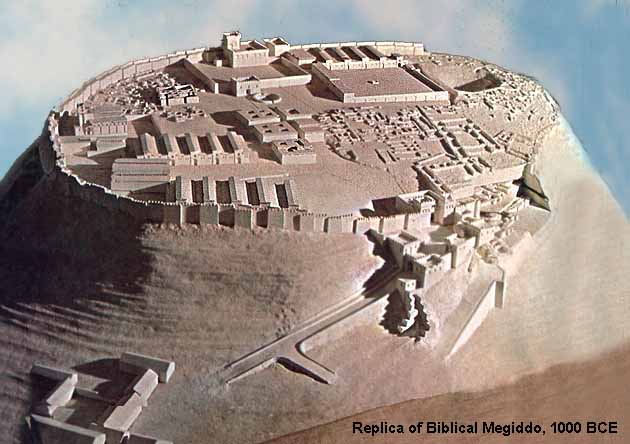 The Palace, Megiddo's LB II, was rebuilt by Solomon. It
contained ivory carved with Egyptian papyrus plants, lotus flowers,
palm trees, winged sphinxes and human headed lions. In addition, a court scene in ivory shows a winged
sun disk. The queen in this scene offers a lotus flower to her husband, the king who is sitting on a throne,
the sides of which are guarded by winged sphinxes. I Kings 10:18-20 .
The Palace, Megiddo's LB II, was rebuilt by Solomon. It
contained ivory carved with Egyptian papyrus plants, lotus flowers,
palm trees, winged sphinxes and human headed lions. In addition, a court scene in ivory shows a winged
sun disk. The queen in this scene offers a lotus flower to her husband, the king who is sitting on a throne,
the sides of which are guarded by winged sphinxes. I Kings 10:18-20 .
According to archeologists, the city of Megiddo was destroyed around 1130 BCE. Within the walls of Megiddo was a palace 260 feet long and 100 feet wide- a huge building for it's time. Pictured here is a replica of biblical Megiddo, around 1000 BCE.
The technique used in building the palace was identical to the one used by the Phoenician craftsmen on the Temple. It was built with ashlar blocks on top of a basalt foundation. The roof must have been trimed cedar beams. This Palace was built in the eleventh year of Solomon's reign. It is also associated with the late bronze age and the reign of Pharaoh Haremheb (late-reign) and Seti I..
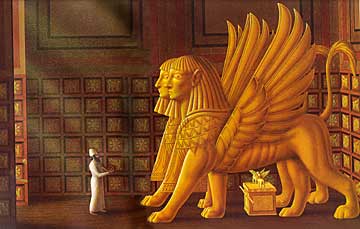 This French site sheds more 'light' on the subject;
The Phoenicia Temple
This short exerpt mentions Baal and El. "There was a magnificent temple to
Melqart/Baal right in the centre of Tyre. All Phoenician temples
incorporated two pillars: originally a wooden one for Astarte and a
stone one for Baal. According to the ancient historian Herodotus, the
Tyrian temple had one emerald pillar and one of gold. The emerald one
may have been green Phoenician glass though given the wealth of Tyre
may well have actually been emerald. It had a candle inside so that it
shone at night: the green obviously symbolises a tree so the emerald
pillar must have represented Astarte’s wooden column. The gold one
symbolised the wealth given by the earth, gold being then the most
precious metal to come out of stone, just as it is now."
This French site sheds more 'light' on the subject;
The Phoenicia Temple
This short exerpt mentions Baal and El. "There was a magnificent temple to
Melqart/Baal right in the centre of Tyre. All Phoenician temples
incorporated two pillars: originally a wooden one for Astarte and a
stone one for Baal. According to the ancient historian Herodotus, the
Tyrian temple had one emerald pillar and one of gold. The emerald one
may have been green Phoenician glass though given the wealth of Tyre
may well have actually been emerald. It had a candle inside so that it
shone at night: the green obviously symbolises a tree so the emerald
pillar must have represented Astarte’s wooden column. The gold one
symbolised the wealth given by the earth, gold being then the most
precious metal to come out of stone, just as it is now."
There is some material evidence of the pillars, too. Clay models of Phoenician temples from the beginning of the first millennium (the time of Hiram, David and Solomon) show the two columns at the temple entrance. Moreover, temples in Cyprus, Samaria, Megiddo, Hazor and Ramat Rahel all had Phoenician-style capitals for their pillars.
Hebrew Ignorance of Building Techniques
The Hebrews never had the enough opportunity to master the art and science of building in Egypt. They were hardened in the desert and in battle but lacked the know-how to build palaces worthy of kings or a Temple worthy of God, the Ark of the Covenant, the Tablets of the Law and the Pentateuch of Moses. These important items of the Hebrew religion were treasured in a tabernacle (tent) up till this point in time.
The Hebrews originally had "judges" not kings. They instituted kings while they were trying to conquer southern Phoenicia because they saw that the Phoenicians and Philistines (Palestinians) were more effective in battle as they had kings who provided strong central leadership.
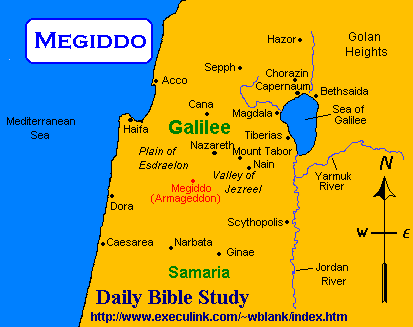 Solomon moved his wife to the palace he built for her'.
I Kings 9:24 . Then he built Fort Millo.
Solomon moved his wife to the palace he built for her'.
I Kings 9:24 . Then he built Fort Millo.
After this time is when the queen of Ethiopia came to Solomon. She had heard how blessed Solomon was with 'wisdom'. She gave Solomon a gift of three million, fivehundred thousand dollars in gold.. It is believed that the queen returned and became one of Solomon's wives and bore him a son. Manelik. Solomon had seven hundred wives and three hundred concubines.
Solomon ruled for fourty years, but all of his decendents were scorned by God because the Hebrew account says Solomon had sined. God gave the kingdom to be ruled by Jehoshaphat. It is believed that around this time is when the Ark of the Covanant was moved secretly to an undisclosed location for it's safe keeping.
(The Bible described King Solomon as the “wisest of men” who could discourse on the biodiversity of all the plants, “from cedars of Lebanon to the hyssop that grows out of a wall, and animals, and birds, and creeping things, and fishes.”)
Solomon's tribute to Wisdom:
She is an inexhaustible treasure for mankind, and those who profit by it become God's friends,
commended to him by the gifts they derive from her instruction. God grant that I may speak
according to his will, and that my own thoughts may be worthy of his gifts; for even wisdom
is under God's direction and he corrects the wise; we and our words, prudence and knowledge
and craftsmanship, all are in his hand. He himself gave me true understanding of things as they
are: a knowledge of the structure of the world and the operation of the
elements; the beginning and end of epochs and their middle course; the alternating solstices and changing
seasons; the cycles of the years and the constellations; the nature of living creatures and
behaviour of wild beasts; the violent force of winds and the thoughts of
men; the varieties of plants and the virtues of roots. I learnt it all, hidden
or manifest, for I was taught by he whose skill made all things, wisdom. For in wisdom
there is a spirit intelligent and holy, unique in its kind yet made up of many parts, subtle,
free-moving, lucid, spotless, clear, invulnerable, loving what is good, eager, unhindered,
beneficent, kindly towards men, steadfast, unerring, touched by care, all-powerful, all-surveying,
and permeating all intelligent, pure, and delicate spirits." see
The Wisdom of Solomon
He could do so (understanding) because in addition to the Wisdom and the Understanding
(intelligence) that were God-given, he also acquired Da ‘at/i—learned knowledge). One of the
'Books of Solomon'
contained all the names of the Angels. In these 'Odes' we also see reference to the Pistis Sophia.
which is another hidden work of the Disciples and Christ that is in the Nag Hammidi Scrolls collection.
Ode 15: The thought of knowledge hath been mine, and I have been
delighted through Him."
The mention of the Dove refers to a lost Gospel to which there are rare references in ancient
writings.
The rejection of Wisdom and Science
However, the traditional attribution of The Book of Wisdom
to Solomon has been soundly rejected in modern times. Says the Catholic Encyclopedia: "at the
present day, it is freely admitted that Solomon is not the writer of the Book of Wisdom,
which has been ascribed to him because its author, through a literary fiction, speaks as if he were
the Son of David."
Literary fiction? We think not! This is only a vague attempt to seperate
Solomon from any act considered heretical by church fathers. Wisdom is eternal and one in being with
the Father. "Because Wisdom is God’s “creative agent”, she must be intimiately identified
with God himself." The next verse says that salvation is an act of Wisdom.
This is not the only such rejection of philosophy to be found in the Apocrypha.
Ben Sira
offers a direct rebuttal to the intellectualism of Koheleth's quest to "seek and search out by
wisdom concerning all things that are done under heaven" (Ecc. I:13). Ben Sira writes "Seek not
out the things that are too hard for thee, neither search the things that are above thy strength.
But what is commanded thee, think upon with reverence; for it is not needful
for thee to see with thine eyes the things that are in secret. Be not curious in unnecessary
matters: for more things are shewed unto thee than men understand"
(Ben Sirah 3:21-23).
This illustrates the 'control' over the people that the church demanded by
not allowing man to study science, mathmetics, astrology, magic and philosophy.
SYMBOLS
1. Angels - Two Rebel angels, Samahazai and Anazel betrayed the secrets of heaven to Solomon. This wisdom was given to Solomon; the understanding to the Queen of Sheba.
2. Sand Storm - The rolling sands will soon drift across the desert burying the Queen's secrets.
3. Gold and Jewels - The gifts of Solomon have no use.
4. Stars - The star symbolized the spirit -- the falling star symbolized the spirit leaving the Queen.
5. Moon - The waning crescent symbolizes decline of the Queen's power.
6. Sheba - Saba -- ancient kingdom in S.W. Arabia -- flourished 950-115 BC.
So much was he beyond the age in which he flourished, in the attainments of science, that both ancient Jewish and Arabic writers have attributed to him a thorough knowledge of the secrets of magic. He gave us in his Proverbs an insight to a deeply religious philosopher, while the long peace and prosperous condidion of his empire for the greater part of his reign, the increase of his kingdom in both wealth and refinement, and the encouragement he gave to the architecture, the mechanical arts, and commerce, testify to his profound abilities as a sovereign and a statesman.
After a reign of forty years, he died, and with him expired forever the glory and the power of the Hebrew empire.
Incidently, although there are many legends and fables from Arabia, Ethiopia and Egypt, this account deals with Jewish history. See I Kings 10:1-13; II Chronicles 9:1-12, Old Testament, Bible.
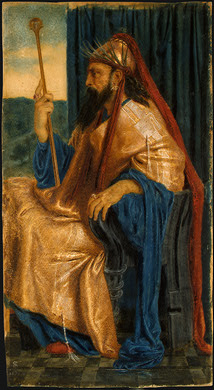 Over 3000 proverbs have been attributed to Solomon, as
well as 1005 psalms, the book of Ecclesiastes and in the
Christian Apocrypha, The Wisdom of Solomon. In this book,
Solomon speaks of wisdom in a voice reminiscent of Makeda:
Over 3000 proverbs have been attributed to Solomon, as
well as 1005 psalms, the book of Ecclesiastes and in the
Christian Apocrypha, The Wisdom of Solomon. In this book,
Solomon speaks of wisdom in a voice reminiscent of Makeda:
"When I reflected in my mind
That in kinship with wisdom there is immortality,
And in her friendship there is pure delight...
I went about seeking how to win her for myself.
I loved her and sought after her from my youth up,
And I undertook to make her my bride,
And I fell in love with her beauty....
So I decided to bring her to live with me,
Knowing that she would give me good counsel,
And encouragement in cares and grief.....
If the possession of wealth is to be desired in life,
What is richer than wisdom, which operates everything?
She understands the tricks of language and the solving of
riddles;
She knows the meaning of signs and portents,
And the outcomes of seasons and periods.
Wisdom is bright and unfading,
And she is easily seen by those who love her,
And found by those who search for her."
Solomon's wisdom was not only political and theological; he was also an expert on natural history. A gardener, he planted olive, spice and nut trees as well as vineyards; he admired and studied spiders, locusts and harvesting ants. According to the Bible, "he could talk about plants from the cedar in Lebanon to the hyssop growing on the wall; and he could talk of animals and birds and reptiles and fish."
THE PSALMS OF SOLOMON The Apocrypha and Pseudepigrapha of the Old Testament in English by the Wesley Center for Applied Theology.
This Ode has strangely appeared in a speech by Salome in
another ancient work called the Pistis Sophia.
1. I will give thanks unto thee, O Lord, because I love thee; 2.
O Most High, thou wilt not forsake me for thou art my hope: 3.
Freely I have received thy grace, I shall live thereby: 4. My
persecutors will come and not see me: 5. A cloud of darkness
shall fall on their eyes; and an air of thick gloom shall darken
them: 6. And they shall have no light to see: they may not take
hold upon me. 7. Let their counsel become thick darkness, and
what they have cunningly devised, let it return upon their own
heads: 8. For they have devised a counsel and it did not succeed:
9. For my hope is upon the Lord and I will not fear, and because
the Lord is my salvation, I will not fear: and He is a garland
on my head and I shall not be moved; even if everything should
be shaken, I stand firm; 11 And if all things visible should
perish, I shall not die; because the Lord is with me I and I
am with Him. Hallelujah. from..
The ODES OF SOLOMON
Compair this ode with the Virgin birth that Eve first
experienced on Passage page 3, quoted from the Nag Hammidi.
ODE 19.
1. A cup of milk was offered to me: and I drank it in the
sweetness of the delight of the Lord. 2. The Son is the cup
and He who was milked is the Father: 3. And the Holy Spirit
milked Him: because His breasts were full, and it was necessary
for Him that His milk should be sufficiently released; 4. And the
Holy Spirit opened His bosom and mingled the milk from the two
breasts of the Father and gave the mixture to the world without
their knowing: 5. And they who receive in its fulness are the
ones on the right hand. 6. The Spirit opened the womb of the
Virgin and she received conception and brought forth; and the
Virgin became a Mother with many mercies; 7. And she travailed
and brought forth a Son, without incurring pain; 8. And because
she was not sufficiently prepared, and she had not sought a
midwife (for He brought her to bear) she brought forth, as if
she were a man, of her own will; 9. And she brought Him forth
openly, and acquired Him with great dignity, 10. And loved Him
in His swaddling clothes and guarded Him kindly, and showed Him
in Majesty. Hallelujah.
Islamic Traditions
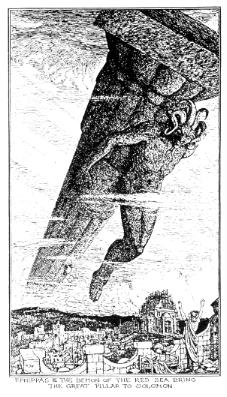 According to Islamic tradition, Solomon was able to
converse freely with animals and birds, understanding their
languages. Because of his wisdom and the grace and favor with
which God endowed him, was able to converse with the spirits
of the underworld who Solomon used as servants. The Moslem
historian al-Siuti gives the following mythical description of
how Solomon built the Temple:
According to Islamic tradition, Solomon was able to
converse freely with animals and birds, understanding their
languages. Because of his wisdom and the grace and favor with
which God endowed him, was able to converse with the spirits
of the underworld who Solomon used as servants. The Moslem
historian al-Siuti gives the following mythical description of
how Solomon built the Temple:
When God revealed unto Solomon that he should build him a Temple, Solomon assembled all the wisest men, genii and Afrites of the earth, and the mightiest of the devils, and appointed one division of them to build, another to cut blocks and columns from the marble mines, and others to dive into ocean-depths, and fetch therefrom pearls and coral. Now some of these pearls were like ostrich's or hen's eggs. So he began to build the Temple . . . the devils cut quarries of jacinth and emerald. Also the devils made highly-polished cemented blocks of marble.. .from The Temple of Solomon
The Amazing Metallic Messiah of Solomon's Temple
Missing Lessons - Solomon's Temple
![]()
The worke of Salomon the Wise called his Clavicle, Revealed by King Ptolomeus ye Graecian.
Truly copyed verbu pro verbo by H:G: in Ann° Christo 1572 in mense Aprielis circa octavo.
[magical diagram in the form of a square.]
The above paragraph is proof Solomon studied the lessons of learned men of his time. Where did he get the information? We have included their studies to further the connections that the Craft Masonry proposed and taught.
When we read about these ancient philosophers we are reminded that these teachings were understood 1000 years before Christ, and are most likely older than that.
"In Phoenicia he [Pythagoras] conversed with the prophets who were descendants of Moses. After gaining all he could from the Phoenician mysteries, he found that they had originated from the sacred rites of Egypt. This led him to Egypt. Following the advice of his teacher Thales, he left through the agency of some Egyptian sailors, and landed on the coast under Mount Carmel."
Pythagoras was a philosopher. In addition to his beliefs
about numbers, geometry and astronomy described above, he held
the following philosophical and ethical teachings:
Without narrating a life of Pythagoras, there are two
important things to remember about him. First Pythagoras was an
initiate of all the ancient mysteries. This fact is reflected
first hand in The Life of
Pythagoras by Iamblichus (B.250 AD).
After receiving all the available teachings of ancient Greece
and presumably initiated into the Eleusinian mysteries and after
consulting all the Greek oracles, he travelled to Egypt on the
advice of his teacher, Thales. Here, he was initiated into the
mysteries of Isis at the hands of priests at Memphis and Thebes.
Like his future successor Plato, he was placed on the Tau wooden cross and raised on the third day from the granite sarcophagus in the Kings chamber. Later, he travelled to Phoenicia and Syria where he was initiated into all the mysteries of Adonis at Byblos and Tyre. Taken captive by the soldiers of Cambyses, he was carried off to Babylon, where he was later initiated by the Magi in the Chaldean lore of astronomy and geometry. Although Iamblichus does not mention this sojourn, he is said to have travelled through Media and Persia into India where he studied for several years as a pupil of the Brahmin priests of Elephanta and Ellora. The name of Pythagoras is still preserved in Brahmin records as Yavancharya, the Ionian teacher.
The Master Kuthumi as Pythagoras, Greek Philosopher and Mathematician (582?-500?BC.) Pythagoras claimed he aquired his knowledge from Hermes.
The knowledge was passed on...
Ptolemy; 331 - 30 BCE.
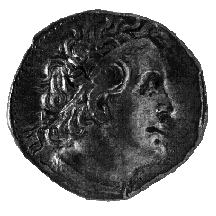 An aid in the study of the Ptolemaic (Macedonian-based
Greek), Roman Imperial (Greco-Roman), and Byzantine rulers of
Egypt based in Alexandria, this portal site is intended for al
classicists and students of Hellenistic history. The House of
Ptolemy web site concentrates on the Ptolemies and their world,
from 331 - 30 BCE. However, since the histories of Greek rule
and subsequent Roman rule overlap (and do so again later with
Byzantine rule) this site includes Roman rule in Egypt, and the
Byzantine rule that followed. During this almost 1000 years the
dominant culture ['Hellenistic'] started as a Greek core with
added native Egyptian and other foreign elements. These
elements were both blended and kept distinctly separate,
sometimes overlying the Greek core incompletely so that today
scholars can focus on the Greek facets, the native Egyptian
facets, the other outside influences, or all of these together
when they discuss The House of Ptolemy and its legacies.
from Ptolemy
An aid in the study of the Ptolemaic (Macedonian-based
Greek), Roman Imperial (Greco-Roman), and Byzantine rulers of
Egypt based in Alexandria, this portal site is intended for al
classicists and students of Hellenistic history. The House of
Ptolemy web site concentrates on the Ptolemies and their world,
from 331 - 30 BCE. However, since the histories of Greek rule
and subsequent Roman rule overlap (and do so again later with
Byzantine rule) this site includes Roman rule in Egypt, and the
Byzantine rule that followed. During this almost 1000 years the
dominant culture ['Hellenistic'] started as a Greek core with
added native Egyptian and other foreign elements. These
elements were both blended and kept distinctly separate,
sometimes overlying the Greek core incompletely so that today
scholars can focus on the Greek facets, the native Egyptian
facets, the other outside influences, or all of these together
when they discuss The House of Ptolemy and its legacies.
from Ptolemy
Ptolomeus; 87 -150 AD
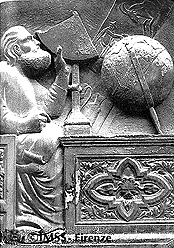 Ptolemy (aka Claudius Ptolemaeus, Ptolomaeus, Klaudios
Ptolemaios, Ptolemeus) The Greek, lived in Alexandria (in Egypt) from
approx. 87 -150 AD. Very little is known about his personal
life.
Ptolemy (aka Claudius Ptolemaeus, Ptolomaeus, Klaudios
Ptolemaios, Ptolemeus) The Greek, lived in Alexandria (in Egypt) from
approx. 87 -150 AD. Very little is known about his personal
life.
He was an astronomer, mathematician and geographer. He codified the Greek geocentric view of the universe, and rationalized the apparent motions of the planets as they were known in his time.
Ptolemy synthesized and extended Hipparchus's system of epicycles and eccentric circles to explain his geocentric theory of the solar system. Ptolemy's system involved at least 80 epicycles to explain the motions of the Sun, the Moon, and the five planets known in his time. He believed the planets and sun to orbit the Earth in the order Mercury, Venus, Sun, Mars, Jupiter, Saturn . This system became known as the Ptolemaic system. It predicts the positions of the planets accurately enough for naked-eye observations This is described in the book Mathematical Syntaxis (widely called the Almagest), a thirteen book mathematical treatment of the phenomena of astronomy. It contains a myriad of information ranging from earth conceptions to sun, moon, and star movement as well as eclipses and a breakdown on the length of months. The Almagest also included a star catalog containing 48 constellations, using the names we still use today. also see Almagest Ephemeris Calculator
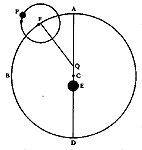 In addition to his well known works in astronomy, Ptolemy
was very important in the history of geography and cartography.
Ptolemy of course knew that the Earth is a sphere. Ptolemy's is
the first known projection of the sphere onto a plane. His
Geography remained the principal work on the subject until
thetime of Columbus. But he had Asia extending much too far
east, which may have been a factor in Columbus's decision to
sail west for the Indies.
In addition to his well known works in astronomy, Ptolemy
was very important in the history of geography and cartography.
Ptolemy of course knew that the Earth is a sphere. Ptolemy's is
the first known projection of the sphere onto a plane. His
Geography remained the principal work on the subject until
thetime of Columbus. But he had Asia extending much too far
east, which may have been a factor in Columbus's decision to
sail west for the Indies.
The Ptolemaic explanation of the motions of the planets remained the accepted wisdom until the Polish scholar Copernicus proposed a heliocentric view in 1543. It should be noted, too, that Ptolemy's system is actually more accurate than Copernicus's . The heliocentric formulation does not improve on Ptolemy's until Kepler's Laws are also added.
It is doubtful that Ptolemy actually believed in the reality of his system. He may have thought of it only as a method of calculating positions.
Ptolemy also wrote Tetrabiblos, a work on astrology. (In those days, astrology was a reputable field of study.)
[Note: There were also a number of Egyptian rulers known as Ptolemy some of whom may have been contemporaneous with the astronomer. Though he lived in Egypt, Ptolemy was a Greek.]
A best seller both in the age of luxurious manuscripts and in that of print, Ptolemy's "Geography" became immensely influential. Columbus-- one of its many readers--found inspiration in Ptolemy's exaggerated value for the size of Asia for his own fateful journey to the west.
Hipparchus
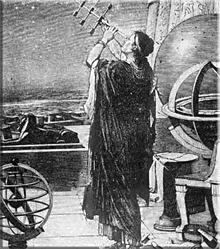 Hipparchus was born in Nicaea in Bithynia, but spent much
of his life in Rhodes. He is generally considered to be one of
the most influential astronomers of antiquity, yet very little
information available about him survives; his only extant work
is his commentary on the astronomical poem of Aratus (third
century B.C.), the Commentary on the Phainomena of Eudoxus and
Aratus. Other works by Hipparchus (now lost) included an
astronomical calendar, books on optics and arithmetic, a treatise
entitled On Objects Carried Down by their Weight, geographical
and astrological writings, and a catalogue of his own work.
Hipparchus was born in Nicaea in Bithynia, but spent much
of his life in Rhodes. He is generally considered to be one of
the most influential astronomers of antiquity, yet very little
information available about him survives; his only extant work
is his commentary on the astronomical poem of Aratus (third
century B.C.), the Commentary on the Phainomena of Eudoxus and
Aratus. Other works by Hipparchus (now lost) included an
astronomical calendar, books on optics and arithmetic, a treatise
entitled On Objects Carried Down by their Weight, geographical
and astrological writings, and a catalogue of his own work.
The Almagest, written by Ptolemy (second century A.D.) is the source of most of our knowledge about Hipparchus, who Ptolemy considered to be his most important predecessor. In his own astronomical work, Ptolemy made extensive use of the work of Hipparchus, building on the foundation laid by him. Ptolemy described Hipparchus as 'industrious' and, repeatedly, as a great 'lover of truth'. That Hipparchus continued to be held in high regard is demonstrated by the various depictions of him on frontispieces of astronomical works published long after his death.
Hipparchus' many important and lasting contributions to astronomy included practical and well as theoretical innovations. He employed geometrical models, including the deferent-epicycle and eccentric previously used by Apollonius (flourished ca. 200 B.C.). One of his contributions appears to have been the incorporation of numerical data based on observations into the geometrical models developed to account for the astronomical motions; Gerald Toomer has credited Hipparchus with the founding of trigonometry. Hipparchus was very interested in observation; his recorded observations span the years 147 to 127 BC.
He used an instrument described by Ptolemy as a dioptra and may have invented the planispheric astrolabe. Hipparchus made extensive observations of star positions, and is credited by some with the production of the first known catalogue of stars. He turned his attention to a wide variety of astronomical questions, including the length of the year, the determination of lunar distance and the computation of lunar and solar eclipses. He developed theories for the Sun and Moon demonstrating (as Ptolemy explained, Almagest, 421) 'that they are represented by uniform circular motions'. Ptolemy noted that as far as he knew, Hipparchus did not establish theories for the five planets, 'not at least in his writings which have come down to us'. But Hipparchus did compile the planetary observations to which he had access into a more useful arrangement, and demonstrated that the phenomena were 'not in agreement with the hyotheses of the astronomers of that time'. Hipparchus' discussion of the motion of the points of solstice and equinox slowly from east to west against the background of the fixed stars is perhaps his most famous achievement; he has been therefore credited with the discovery of the precession of the equinoxes. Otto Neugebauer has suggested that Hipparchus, in fact, invented the theory of trepidation.
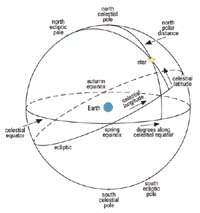 Perhaps most intriguing for historians of astronomy is
Hipparchus' use of Babylonian astronomical material, including
methods as well as observations. Many questions remain
regarding the relationship between Babylonian and Greek
tronomy, but Hipparchus' work provides a clear link. Toomer has
argued that Hipparchus was responsible for the direct
transmission of both Babylonian observations and procedures and
for the successful synthesis of Babylonian and Greek astronomy.
Hipparchus and Trigonometry
Perhaps most intriguing for historians of astronomy is
Hipparchus' use of Babylonian astronomical material, including
methods as well as observations. Many questions remain
regarding the relationship between Babylonian and Greek
tronomy, but Hipparchus' work provides a clear link. Toomer has
argued that Hipparchus was responsible for the direct
transmission of both Babylonian observations and procedures and
for the successful synthesis of Babylonian and Greek astronomy.
Hipparchus and Trigonometry
We told you on Forbidden How the Nephilim/Gods brought us their planatary knowledge and actually named the planets for us, showed us where they were and explained why Pluto orbits clockwise and in a retrograde motion. Their planet is approaching us again as it does every 3600 years. If you doubt this read and study for yourself the sumerian texts.
![]()
Solomon; The Prologue.
Manuscripts of the 'Key of Solomon' in English
British Library MS. Sloane 3847.
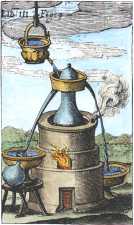 "Here begineth the prologue of ye Booke of Clavicles of
Salomon containinge the Secrets of all Secrets of all crafts
magicall of Nigromancy, the which booke of Craftes as Ptolomei
the most wisest philosopher on greece, doth testify. Remember my
sonne Roboam more dearer to me then Isaack, for I had all my
Scyience of ye Creator or all Creatures. Roboam sayd what have
I deserved. Why should I in any case be likened to my father.
Salomon sayd, I have revelation by an Angell of God, it chanced
on night, in my sleepe I named the holy name of god. Isaack and
I desired to have the ineffable wisdome of god, for ye Angell
Raziell appeared to me in my sleepe, shewinge this ennarration
gently, Salomon, shut or tye the secretts of secrets, for it
shall be time that all wisdome shall be destroyed and shall be
hydde and shall come to nothing, and ye shall know that time is
nye..."
"Here begineth the prologue of ye Booke of Clavicles of
Salomon containinge the Secrets of all Secrets of all crafts
magicall of Nigromancy, the which booke of Craftes as Ptolomei
the most wisest philosopher on greece, doth testify. Remember my
sonne Roboam more dearer to me then Isaack, for I had all my
Scyience of ye Creator or all Creatures. Roboam sayd what have
I deserved. Why should I in any case be likened to my father.
Salomon sayd, I have revelation by an Angell of God, it chanced
on night, in my sleepe I named the holy name of god. Isaack and
I desired to have the ineffable wisdome of god, for ye Angell
Raziell appeared to me in my sleepe, shewinge this ennarration
gently, Salomon, shut or tye the secretts of secrets, for it
shall be time that all wisdome shall be destroyed and shall be
hydde and shall come to nothing, and ye shall know that time is
nye..."
[Text in English with prayers in Latin.]
Here beginneth the first booke of the Clavicles of Secrets
as the most wisest philosopher, Ptolomy the Grecian sayeth.
Of which days, howres and poyntes nessesary and experiments magical.
Of arts magicall or nigromanticall, or of some spirits how
they should beordered.
[Circle of the Art diagram.]
These prayers followinge ought to be sayed at your uprisinge.
The Rubrice of exorsization.
[First the ‘Conjuration', then the ‘Admiration']
After you have donne in the East and South, then say to the
West and North pts.
How and by what manner the pentacles be made.
Heare followeth the forme and manner of the pentacles or
canderarin distirecoes.
How experiments should be made and ordayned for theft.
How experiments of invisability should be prepared.
How experiments of Love should be ordayned.
How experiments of grace and imprecration should be prepared.
How experiments of envy and destruction should be ordayned.
How experiments of mockinge and laughinge should be prepared.
How experiments extraordinary be prepared and ordayned.
Finis primi libri Claviculi Salomoni. Heare endeth the first
prologue, and heare beginne the Prologue of the 2nd Booke, as
Ptolomeus the grecian witnesseth, that hath elucidated and made
cleere the Secrett of secretts from obscure Darkness...
Heare beginneth the rubrice of the 2nd Book.
[Text in English with prayers in Latin.]
Ch 1 What howres the artes and experiments ought to be
fulfilled and exercised when they be prepared.
Ch 2 Of Fastinge in Custody.
Ch 3 How the Coniurer should order himselfe.
Ch 4 Of Bathes and how they should be.
Ch 5 How the fellowes and scollers should doe.
Ch 6 Of Clothinge and Shooes.
Ch 7 Of Places where they should coniure, and where
the crafts should be excersised and made, and the experiments.
Ch 8 Of the knife, the Sword, Vel, arthano, or the
instruments, by what means they worke in the Craft.
Ch 9 How the Circles be made, and how ye should enter into them.
Ch 10 Of the fumigations of all artes and experiments.
Ch 11 Of Water and Isope, and how ye should worke.
Ch 12 Of Light and Fyer, and how ye should worke with them.
Ch 13 Of the precepts of all artes and experiments.
Ch 14 Of Pen and Inke, and other colloures, and how ye should worke.
Ch 15 Of Virgin paper how ye should worke.
Ch 16 Of a Penne, and an instrument to write withall.
Ch 17 Of certain bloud necessary in artes and experiments.
Ch 18 Of a needle, and an Instrument of Iron, how to make them.
Ch 19 Of Caracters to be written, how they should be wrought.
Ch 20 Of the Sacrifice, and how it should be done and wrought.
Ch 21 Of the silke or linnen cloth to put the hallowed things in.
Ch 22 Of the worke of Images, and of Astronomy."
Heare followeth one the other side the forme of the circle whosoever be in such a circle shall be as sure as in a very stronge Castle wherein he needeth to feare nothinge.
Hic incipit opus mirabile et etia verissima de 40 annulis sapientissimi salomonis.
[text in Latin]
[four square diagrams with enclosed circles.]
[Item 3 - Sepher Raziel.] from The Alchemy Web Site
We also recommend this page Solomon By Richard ( Fireplug )- Underground Streams
![]()
THE MISTS OF ANTIQUITY
By Bro. W. J. (Jack) Collett, P.G.M.
(81-03-21)
When we talk about the origins of Freemasonry we frequently say that they are buried in the "mists of antiquity." This means that the beginnings of the Craft are not easily definable. For some students of Masonic history the "mists of antiquity" lie in the history of Freemasonry previous to the origin of the four Speculative Lodges that operated in London, England, and ultimately came together to form the Grand Lodge of England in 1717. This means a study of the great manuscripts that record the "Charges of Freemasonry", such as the "Halliwell Manuscript", also known as the "Regius Poem", which dates at approximately 1380 A.D., and the "Cooke Manuscript" which comes from about 1450.For others it means an attempt to trace the origins of the Craft back to the building of King Solomon's Temple at about 975 B.C. This is because our ritual and the Hiramic Legend are so closely connected with the events of the reign of King Solomon. It is doubtful that the moral teachings or, indeed, any of our ritual came from that period. Bailey and Kent, the authors of a standard textbook called The History of the Hebrew Commonwealth, make the startling comment that "If there was anything done in Solomon's reign to strengthen the people in material or intellectual ways, if there was any endeavour to purify religion or elevate morals, we do not know of it. No heroic or noble act is recorded of anyone while Solomon was on the throne." Of Solomon the scholars say, "The empire was his slave, and the sole end of its toil was his pleasure. No country can long stand such a strain." These words are true historically. After the reign of King Solomon the empire that King David had built disintegrated, and the years that followed were filled with chaos.
Masons, quite naturally, recoil from the verdict of such scholarship. The words strike at the very roots of some teachings that we hold dear. Did not the Legend of Hiram Abif come out of King Solomon's reign? Did not Solomon mourn for the loss of his architect and order that he be decently interred? liere not the villains in the Legend given their just deserts? Of all these things we have no real evidence in the Old Testament. It is true that in the First Book of Kings, Chapter VII, and in the Second Book of Chronicles, Chapter II there are very brief references to Hiram. However, there are no real details. The legend that grew up around him dates from the early 1700's. The first real evidence that any Lodge used a dramatized version of the Hiramic Legend puts the date as late as 1722. Thus it is that some of the Masonic traditions that are dearest to the hearts of Masons are "buried in the mists of antiquity."
From whence then came the moral and spiritual teachings of Freemasonry? From whence came many of the mystic rites that we now perform?
In order to understand some of these difficult questions we must first of all remind ourselves that Christianity and Freemasonry were from the earliest times-closely bound together. Our forebears, the operative masons, were men who built the majestic cathedrals of Europe to honour Jesus of Nazareth, who was of humble origin and who, most certainly, would not feel at home in some of the beautiful edifices erected in his honour. Indeed, many of the intricate ceremonies conducted in those cathedrals would be completely foreign to him. Let us remember that his public ministry lasted but three short years, and all he left behind him were eleven followers who had to meet in secret, because they feared the wrath of both the people and the governments. Later came an elaborate system called the Christian Church, complete with numerous ceremonies and mystic rites. With that development Freemasonry was closely linked in spite of the fact that today we claim it to be a Universal Science with no special religious ties. The latter claim is quite true, for Freemasonry as well as Christianity attracted to itself many practices other than those of the Hebrew Religion.
There existed both in the Greek and Roman cultures certain practices known as the Mystery Religions. These were not confined to Greece and Rome. Evidence of them may be found in the early cultures of China, India, Egypt, and other ancient civilizations. They were secret religious assemblies with special initiation rites, and most certainly were present in the time of Jesus. Undoubtedly they had an influence on the growth of the ceremonies of early Christianity. In fact, the Apostle Paul in some of his letters found it necessary to protest against the intrusion of pagan practices into the Christian Church. In one instance he warned the new Christian converts that they must not drink to excess at the Lord's Supper.
At another point he emphasized that he did not participate in the growing practice of baptism. Despite the warnings some of the customs of the Mystery Religions became an integral part of Christian Ritual. One only needs to examine some of the mysticism surrounding the festivals of Christmas and Easter to understand the syncretism that occurred and has been Lost as the centuries have passed. We should remind ourselves again that the Roman Catholic Church, with its elaborate ceremonies, was once the main support of Freemasonry and the ceremonies connected with that order. All of the ceremonies of the Christian Church and of Freemasonry contain overtones of the ancient Mystery Religions.
The Mystery Religions were very selective in their membership. No uninitiated person was permitted to take part in the ceremonies. Note the relationship here with the Christian Holy Communion, and also with the practices of Freemasonry. The Mystery Religions appear to have had a double purpose. First, they wished to hand down, from generation to generation, the traditions associated with the gods in whose honour they were organized. Secondly, they taught very carefully how certain rituals were to be performed, and then trained their initiates to carry out those rituals exactly. Under no circumstances were there to be variations from the ancient traditions, even in the words of the rituals.
The prime purpose of the Mystery Religions was not to teach dogmatic religious beliefs; it was to strive for the moral improvement of their membership. The rituals were designed not only to improve the morals of the adherents, but also to implant in their membership a hope for the life that would go on after death.
The first remarkable resemblance between the Mysteries and Freemasonry is that membership rested on the voluntary choice of the individual. No one was ever invited to belong to a mystery religion. The individual had to volunteer to become a member. If the individual indicated his desire and if he were accepted, then he had to submit himself to the Initiation Rites. These rites were designed to provide for the candidate an emotional experience that would tie him forever to his religion. When that was done he was accepted into a fellowship, designed to give him support as he became more and more absorbed into a community of regenerated individuals.
The ultimate goal of the Mystery Religions was to establish a relationship between the individual and the gods. It was supposed to be an intimate and personal type of communication, that would bring to the individual the particular help he needed to live the type of life expected of him as a member of the religion. For the Mysteries the initiation rites sought to bring the individual, no matter what his age, a sense of being born again and, as he grew in knowledge, to admit him to a sense of maturity that he did not possess before. After he was initiated and as he was transformed from childhood to maturity, he was expected to share in the social duties of the religion. The social and moral issues that faced the particular nation became his responsibility.
One of the most important aspects of the Mystery Religions was the program of instruction for the Initiates. Each new member was required to take time to go through a course of instruction. He was taught how he should act in the ceremonies of the group, and what he should do in his relationships with his fellow members and his community. He was encouraged to think in terms of the philosophy of the religion and the means of transfering the thought into action.
There are many things about the Mystery Religions that are not known. The reason is that the religions had an inviolable rule that all Initiation Rites and instruction were transmitted by word of mouth. It was forbidden that anything be written. Thus the customs and traditions were handed on orally from individual to individual and from group to group. We have never been able to discover, for instance, what exactly happened in the Ceremony of Initiation. On the other hand it is known that the total effect of a Mystery Religion was to weld a chain of continuity that lasted through the ages. The system disappeared with the growth of the Christian Religion, and the collapse of the Roman culture in the early years of this era. When Rome was overrun by the barbarians of Europe in the First Century A.D., the Mystery Religions, as such, disappeared, although remnants of heir practices survived.
The Mystery Religions were always connected with a god. The ancient peoples generally worshipped many gods, but from that variety of divinities a Mystery Religion adopted one that it worshipped and to which it paid special loyalty. They customarily selected a god that had something to do with fertility and growth. Hence, some of them became associated with fertility rites, and out of that some practices grew up that put some of the religions into disrepute.
There were cults that developed systems of male prostitution and homosexual acts. From such things arose an aura of suspicion over the secret meetings of the mysteries, and questions were raised constantly about what actually went on in the initiation rites. It is safe to assume that the majority of the mysteries sincerely sought to raise the moral life of their membership, and the abuses of secrecy were minor.
The ancient people lived continually on the edge of starvation. They were not knowledgeable enough of the world to understand the inevitable change of seasons, and were often surprised when the long period of winter arrived and nothing grew. Of course, they frequently did not have the expertise to store food for the time when the land did not produce. Even greater than their distress over the winter season was their awe and surprise when spring arrived, and the world appeared to be born again, with new growth and an abundance of food. In their minds, however, there was no certainty that spring would follow winter and that harvest would follow the spring. This routine always, in their minds, was subject to the whim of the gods. If the gods were pleased, then growth would follow. If the gods were angry, then famine would occur. It was essential for them to find ways of keeping the gods in good humour, and thus to assure the return of the spring. Many of the rituals connected with the Ancient Religions were directed towards the pleasing of the gods. Even in the Old Testament we read that the smoke from the sacrifices in the temple was pleasing to God and he rewarded his people.
Because the ancient peoples were so concerned about survival and the assuring of the regular succession of seasons, their great legends had to do with their great concerns. It came about, too, that the contents of the Mystery Religions were mainly communicated by means of legends. In the legends the Earth is usually thought of as the great Goddess of Fertility, This goddess grew old and feeble as the autumn season approached and was continually in danger of death. If the Goddess of Fertility died, that would mean that the primitive man would suffer from hunger and, perhaps, starvation. The idea of the Goddess of Fertility dying filled the early peoples with terror. Therefore, it was essential that a magical rite be performed that would assist the Goddess of Fertility to survive the dangerous period of winter. Through this magical rite the goddess, in danger of dying and making the earth barren, would be brought to life again and once more possess a young and vigorous body. The result would be that fertility would be restored to the earth and people would be able to eat once more.
The Adonis Myth very likely originated in Babylon but it is best known in its Greek version. Adonis was the vigorous and youthful lover of the great Mother Goddess. Her name was Ishtar and she embodied all the reproductive possibilities and energies of nature. If Adonis died, Ishtar was without a lover, and she would not be fertilized and consequently would fail to reproduce. Each year Adonis, the vigorous lover, would die and pass into the world of the shadows. Each year after his death Ishtar desired to be fertilized and she would seek unceasingly to find her lost lover, for without Adonis the period of reproduction would cease. The situation was so desperate that messengers would be sent to the Queen of the Underworld, pleading for the return of Adonis to the bed of Ishtar. In the meantime Ishtar herself, barren and cold, would go to the underworld to seek for her lover. She passed through the seven gates of the underworld and each time.
She had to pay a fee, which was one of her garments. Finally, naked and alone, the Great Mother Goddess would appear before the Queen of the Underworld. The Queen would refuse to release Adonis until the messengers of the gods arrived, to sprinkle the Water of Life on both Adonis and Ishtar. When this was done they were raised from the tomb of death to the upper world. When the raising was complete the wonderful world of nature was revived and hope reborn for the fertility of the world.
This legend is significant because it embodies several facets of the Christian Religion. The sprinkling of water, the descent of the hope of the world into the realms of darkness, the revival of life and hope for the world. It also has within it elements of the legend of Hiram Abif. The lost hero, the search for the lost heroine, and the raising from darkness into the newness of life.
Another legend has in it Adonis, a beautiful child, whom Aphrodite deeply loves. In order not to be deprived of the love of Adonis, Aphrodite conceals Adonis in a chest, and leaves the chest in charge of Persephone, the Queen of the Underworld. Persephone looks in the chest and sees the beautiful youngster.
She immediately falls in love with him and refuses to return the chest to Aphrodite. To recover the lost love Aphrodite herself descends into the realms of darkness in a desperate effort to recover the lost child. The dispute between Aphrodite and Persephone rages, so that the whole of the underworld is in disarray. At length the god Zeus is forced to intervene. He rules that the child must remain for half of the year with Aphrodite, and with Persephone the other half.
During the part of the year that Adonis is with Aphrodite the world is warm and it is a period of reproduction, growth, and plenty. When Adonis is with Persephone the world is cold, lacking in growth, and unproductive. When the time comes for Adonis to live with the Queen of the Underworld he is lowered into her presence with great sorrow and lamentations. When the vital words are spoken and the time has come to restore Adonis to Aphrodite, the child is raised very carefully from the darkness into the light. This is a time of great joy, feasting and rejoicing.
The ancient legends of the raising of an individual from darkness into life are many. The details of the event are varied. The main outline remains throughout them all. Involved are fertility and growth, the discovery of some secret means to do the raising, then the change from death to resurrection. Basically the legends all contain the same story. A god dies and the earth becomes unproductive. The god is restored to life and the earth becomes fertile and productive. Each Mystery Religion in every early culture had its legends, illustrated by accompanying rites and ceremonies. Only those who have been properly initiated know the particular legend. Those who are permitted to perform the rite of resurrection are the ones who have been taught carefully and are skilful in performing the required ceremonies, that will ensure the resurrection of the god. Connected with the ceremonies are certain signs and symbols. These are revealed to the new initiates when they have received sufficient instruction to appreciate the essential essence of the purpose of the religion into which they have been received after requesting membership.
Osiris was the son of the earth god Seb and of the sky goddess Nut. He had two brothers, Horus, the elder, and Set. There were also two sisters, Isis and Metphthys. Notice that the family comprised a total of seven, and that there are five children including three boys. Osiris taught the Egyptians how to grow corn. Set, the god of evil, was jealous of the popularity of Osiris. He conspired with 72 villains to murder him. They made a chest and persuaded Osiris to get into it. When Osiris got into the chest they nailed it down securely, and flung it into the River Nile. Osiris was discovered to be missing, and there was great concern over the fact that the great teacher had been lost.
Isis, on hearing the news, was greatly distressed. She had her hair cut and put on clothes of mourning. Then she set out in search of the body. In the meantime the chest had floated down the Nile to the town of Byblos, in Syria, and there it became stranded on the sand. An Erica tree grew up over the chest and completely enclosed it in its trunk. The King of Syria decided that the tree should be cut down and that it would be used to form a great pillar in his palace. Isis arrived in Syria and went to the King's Palace. She begged for the pillar and her pleas were heard. She cut it open, found the chest and within it the body of Osiris. Isis threw herself on the body and brought it back to life. Osiris was raised from the chest in a great ceremony. The 72 villains were discovered and put to death. Osiris, having been raised from darkness to renewed his vows to serve his people. He returned to Egypt and continued to teach his people how to make their soil fertile, how to produce crops of corn and how to feed the people.

Space will not permit to relate more of the fascinating legends that have been preserved out of the "mists of antiquity," yet it is hoped that the Masonic reader recognizes the similarities between them and the Legend of Hiram Abif. Certainly the legend does not come from the Old Testament. The story in the Old Testament tells of Hiram, King of Tyre, sending another Hiram, the son of a widow, to help Solomon build a temple (II Chronicles 2:13 and I Kings 7:13). If the story is read carefully it can be seen that Hiram, the widow's son, was not so much the architect as he was a skilled worker in brass, stone and purple. Chronicles says that Hiram's mother was "of the daughters of Dan" while his father was a man of Tyre. Tyre, by the way, was one of the great centres of the cult of Adonis. Beyond these scanty facts the Old Testament tells us nothing. There is no record of the murder of Hiram, not even any indication that he died. It is evident that he had dropped out of the picture by the time that the temple was dedicated.
As stated at the beginning we do not know where the Legend of Hiram originated, but we do know that it did not become current until the eighteenth century. In this the legend does not differ very much from the lack of knowledge as to the origin of much of our ritual. It is feasible to speculate that it was written by some scholar who had steeped himself in the legends of the Mystery Religions. Certainly all the ingredients are there; the murder of a productive god, the disposal of the body by the powers of darkness, the discovery of the body by the powers of light, the raising of the body from darkness to light, and the return to productive living. In addition there are the accompanying signs and symbols, which are kept secret. There is also the dedicated journey of those who sought for the body and the ultimate discovery of it, and the punishment of those who sought for the hero's death and the honour bestowed upon the person who was raised.
We are attempting in this paper to discover origins, but we must also note that the Legend of Hiram has been carefully refined and adapted to the lessons that the science of Freemasonry teaches; to wit:
1. Hiram, in the Masonic Legend, is not restored to life as are the gods of the Mystery Religions. The Christian Religion follows the Mystery Religions to this conclusion. To have life restored in the Masonic Ritual would introduce a strange and jarring note. The writer of the Hiramic Legend appropriately ends it with having the remains properly interred. However, the signs and symbols remain. They are transferred to the candidate, who is urged to remember the noble example of a man who would rather suffer death than betray a sacred trust that had been vested in him at his initiation and throughout the instruction that he received after his voluntary entry into the order.
2. The raising of Hiram in the Legend symbolizes the entrance of the human soul into a new and better stage of experience. It points out that it is the duty of all men to prepare themselves for a new life, by following the glorious example of dedication and perfection. it should be noted that an element of resurrection remains. Although the bones are interred, the new life, the resurrected one, is transferred to the candidate. What more meaningful idea of the resurrection can there be than that the goodness of the person who has died lives on in those for whom he lived?
3. The Hiramic Legend in Freemasonry does not have the magical elements that are common to the legends of the Mystery Religions.
In one of the versions of the Osiris Legend, Isis, a virgin, throws herself on the dead body of Osiris and immediately becomes pregnant, and later is the virgin mother of the god Horus. The reason for raising the body was so that it might be interred in consecrated ground. Certain signs are learned by those who raise the body, but they are not the genuine secrets. Those have yet to be discovered. The quest does not end with the raising of the body. The search must go on, for the purpose is the unending search for eternal truth. It is only by constant struggle to attain the elusive truth that we can live the life triumphant. This version comes as close as we can get in the ancient legends to the teaching of the Hiramic Legend, namely that the search for the missing word must go on into eternity.
4. The Hiramic Legend does not end in crass materialism as do most of the mysteries. The conclusions of the Legends of the Mysteries indicate that the ancient peoples, because of their exploits, assure themselves of material gain, such as the return of food after the winter barrenness. The lesson we learn in Freemasonry is that there is another way of living that is far higher than the material one. It is the world of brotherhood and service in this present life. After that, when this transient existence is ended, we may find a happier and more abundant life. Until the time of transition arrives from the present to the eternal future, we must be faithful to our obligations and to our duties. We must learn to live at peace within the mysteries that constantly surround us.
It is impossible to assert with any certainty exactly where the Legend of Hiram Abif originated, or to find any documented account of its direct relationship to the Mystery Religions of the ancient cultures. It is possible for us to say that the Hiramic Legend and all the ancient legends form a part of humanity's great quest for the meaning of life and death. That originated with man as he became a conscious and thinking being, and will not end until man vanishes from the face of this earth, either because of his own foolishness or because of his disappearance in the process of evolution. The legend is a part of the ongoing stream of human thought.
To take a speculative journey through the Mystery Religions, for this author, enhances the Legend of Hiram Abif and greatly enriches its meaning. No longer is Hiram only a man of honour who is willing to sacrifice his life rather than betray a sacred trust. He stood for something far greater. He became a part of humanity, reaching out to an unknown power seeking for some assurance of permanency and love. Man has frequently fallen into the error of thinking that if he could make corn grow, if he could amass corn, so that he had to pull down the small granaries and build larger ones, he would have attained something that could not be destroyed, namely wealth and power. The legends, especially the Hiramic one, say something more. They say there is more to life than material wealth and strength.
A long succession of prophets, priests and kings, including Hiram Abif, have been sacrificed on the altar of crass materialism. Even in death these men have not been silenced, but have lived on in the lives of those who seek the truth embedded within the legends. There is a life beyond and that is the life of the spirit. It is the life of the spirit that holds the true secrets, and they rest only in the thoughts of the Master Mason of all Mankind.
Hiram was not the first builder to be slain nor was he the last. Today the eternal temple will not be built by men who seek for advantages of their own, but it will be built with devotion, sacrifice, death, and resurrection.
BIBLIOGRAPHY
Bailey, A. E. and C. F. Kent, History of the Hebrew Commonwealth, Chicago: Charles Scribners' Sons, 1920
Bergson, Henri, Morality and Religion, New York: Henry Holt and Company, 1935
Fein, Vergilius, Living Schools of Religion, Ames, Iowa: Littlefield, Adams and Company, 1958
Fowler, H. T., A History of the Literature of Ancient Israel, New York: The MacMillan Company, 1912
Frazier, Sir James G., The Golden Bough, London: MacMillan and Co. Ltd., 1924
Hamilton, Edith, Mythology, New York; New American Company, 1969
Jones, Bernard E., Freemason's Guide and Compendium, London: George G. Harrap & Company, 1950
Marks, M. and M. Rosenbaum, "Hiram Abif", The New South Wales Freemason, April 1971
Pick, F. L. and G. N. Knight, The Pocket History of Freemasonry, London: Frederick Muller Ltd., 1956
Robinson, C. C., The History of Greece, London: Methuen and Co. Ltd., 1932
Zimmerman, Alfred, The Greek Commonwealth, Oxford: Clarendon Press, 1924
Mackey, A. G. and W. R. Singleton, The History of Freemasonry, Masonic History Co., 1906 (seven volumes)
All material in this site may be used
to educate everyone, Masons and
non-Masons alike about Freemasonry
and for the promotion of Freemasonry.
copied in it's entirity from Oak Forest Lodge# 1398, Houston, Texas

Search this site
Our search Engine does not search for the links in this site, only words in the text.
If you have learned something you didn't know about - sign our guest book. We'd love to hear from you.
We lost our previous guest book with no warning. Please sign this one.
Guestbook
NO PART OF THIS SITE MAY BE COPIED OR REPRODUCED, IN WHOLE OR IN PART WITHOUT THE EXPRESS WRITTEN APPROVAL OF THE WEBMASTER.. .© COPYRIGHT 1999 - 2012 c.i.c.ALL RIGHTS RESERVED